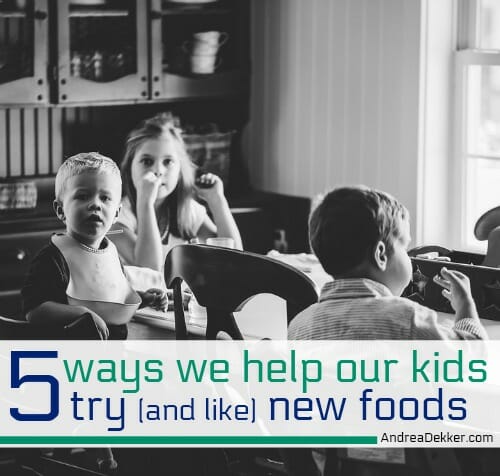
Getting our children to eat has been a battle for our family since day 1, with Nora refusing to eat anything other than breastmilk until she was two (after 2 rounds of food therapy).
Since then, Nora has become an amazing eater and the other 3 kiddos have thankfully been much easier to feed.
However, as with all kids, they still have their “favorite foods”, they still need a fair amount of encouragement to eat their veggies, and they still usually protest anything “new” or “different” even before they give it a try.
Can any other parents relate!?!?!
Always and forever in favor of “moderation”, I’ve never been one to set strict food limits for my kids. They have candy every day, they have multiple snacks everyday, we have some sort of dessert after lunch and dinner, and we enjoy occasional trips to Culver’s, Arby’s, and Little Caesar’s.

My kids also eat a wide variety of fruits and veggies with every meal, they often request raw veggies or a banana as their snack, and they wolf down 100% whole grain bread and pancakes like you wouldn’t believe.
.
The icing on the cake (pun intended) for me is that they regularly TURN DOWN DESSERT if they feel too full after a meal!
This is so encouraging for me because I know they are listening to their bodies and only eating when they are hungry, not simply because food is there (something most adults should learn to do).
.
I would NOT say our kids are super adventurous eaters… but I wouldn’t say they are overly picky either.
I’ve been impressed with the variety of foods they eat and enjoy. In fact, over spring break, we took the kids to a buffet and Dave and I both mentioned how well the older 3 did choosing appropriate foods (and trying different foods).
This is not to say we never have to force our children to try something… but rather, it’s encouraging for us to see some of our hard work actually paying off!
If you struggle to get your children to try (and like) new foods, here are 5 relatively simple (yet effective) tips that have worked for us over the years.
1. Give them ONE bite over and over and over again.
Our kids know that they must eat at least one fairly large bite of every food for that meal, otherwise they won’t get second helpings of any of the foods they do like.
I always put all the food on their plates before I bring them to the table, and I put roughly one bites-worth of each food I know they might not love.
Nora is smart and eats all these foods first, Simon ALWAYS saves them until the very end, after he has eaten everything he loves, and after the new foods are cold. Sigh…
Whatever the case, they know that eating the foods I put on their plate will gain them access to unlimited additional helpings of the foods they DO like… and surprisingly enough, they regularly end up liking the new foods they try (maybe not the first time, but after many repetitions, they develop a taste for it).
.
2. Serve plenty of other foods they DO like.
As many of you know from reading our meal plans within my Peek Into Our Week posts, I serve a HUGE variety of side dishes with every single meal.
This is partly because Dave and I enjoy eating a variety of foods for every meal, but also because it assures everyone will like at least a few things I’m serving.
There are always several different types of fruit and veggies at each meal, plus applesauce and fresh bread — and although we do not let them only fill up on fruits, veggies, and bread, we do let them eat a significant amount of these items AS LONG AS they eat at least one large bite of everything else (per #1 above).
Also, I should mention that we try to give them some ownership over what they get on their plates… yes, they all have to try a little bit of the main meat, potato, pasta, casserole, etc. but they they can choose the 2 or 3 fruits and veggies THEY want to have. Sometimes, this is easy as they like all the options I have; other times, they need to choose from options they don’t particularly care for, but they know they just need to eat one good-size bite and it’s easier to enforce when THEY pick the foods.
.
3. Mix it with something they already like.
Our family switched to maple syrup a few years ago… but Nora absolutely REFUSED to eat it.
I eventually gave in and I told her I would buy one more container of the “old” syrup for her — she felt super special because she got her “own syrup”.
As she used up “her syrup” I continually added more and more maple syrup, until I’m fairly confident she was just eating maple syrup out of the Hungry Jacks bottle.
Then, after many MANY months of eating maple syrup from “her bottle” I eventually told her what I did and said we were only eating maple syrup from now on.
She didn’t have a fit, she didn’t complain, she just looked at me, and then ate her pancakes. We haven’t had any issues since then and she has never complained about maple syrup again!
I realize transitioning to new foods might not always be this easy but it has worked wonderfully for me over the years.
I’ve done something similar to switch my kids over to plain yogurt (mixing it with different amounts of vanilla for many months) and whole grains (mixing it with half all-purpose flour for a while).
I’ve also gotten them to eat spaghetti squash by first mixing it with regular spaghetti noodles and their favorite sauce + cheese + pepperoni. They gobbled it up!
It’s honestly amazing how many new foods I can get my kids to try (and eventually like) just by mixing them in with things they already like!
.
4. Disguise the food and/or packaging.
I guess this is sort of what I did with the syrup mentioned above — but I have so many other examples of how this has worked wonderfully for our family.
I regularly bake chicken with a coating of bread crumbs, herbs, and Parmesan cheese; the kids LOVE this meal and request it often.
About a year ago, I started making Tilapia this exact same way and simply told the kids it was chicken… NO ONE NOTICED!
I eventually told them it was tilapia and they all looked at me like they were going to throw up! They couldn’t believe they had been eating (and enjoying) fish!
Similarly, our kids insisted they didn’t want “whole grain” anything — no pancakes, no waffles, no bread, etc.
As I mentioned above, I started mixing SOME whole grain flour into our various bread products earlier this year when I began grinding my own grain. I continually added more and more whole grains until I was ready to nix the all purpose flour… but I knew the kids would notice because the whole grain products LOOKED different.
I dodged this issue with a little food coloring and sugar!
I colored their pancakes so they couldn’t see the darker color of the whole grain, and I added chocolate chips, fruit, and whipped cream. I also slathered their whole grain bread with butter and my homemade jam as a special treat at dinner.
The kids thought this was the BEST ever, and have honestly never said a word about disliking whole grain foods ever since (even without the extra sugar!)
They still insist they don’t like avocados, yet they eat my yummy chocolate, peanut butter avocado pudding (that is essentially ALL mashed avocados with a little bit of peanut butter and cocoa powder).
They can say whatever they want… I’ll just keep disguising foods so they eat them!
.
5. Show them that we enjoy those food items.
Obviously, none of my tips above would work if Dave and I weren’t also eating (and enjoying) the foods we wanted our kids to eat!
We eat a huge amount of fruits and veggies, we are willing to try almost anything, and I’m always looking for new recipes so we don’t get tired of eating the same thing over and over again.
I also think it’s important to note that we almost always eat WITH our kids at the table.
Since our kids are still young and don’t have many extra curricular activities, we eat dinner together 99.9% of the time. I also eat breakfast and lunch at the table WITH the kids almost every single day. And Dave is home on the weekends and ALL summer long — so it’s not uncommon for us to eat 3 meals a day together at the table on non-school days!
.
I know these tips won’t work for every family, and those of you with older kids will get MUCH MORE PUSH BACK.
However, I do think they are worth trying… and trying and trying (remember, persistence is key when it comes to developing a new habit or a new preference!)
Like I mentioned above, our kids definitely are NOT the most adventurous eaters around, but they are willing to try new things — and they often surprise themselves by what they end up liking!
What are your best tips for encouraging kids to try new foods?






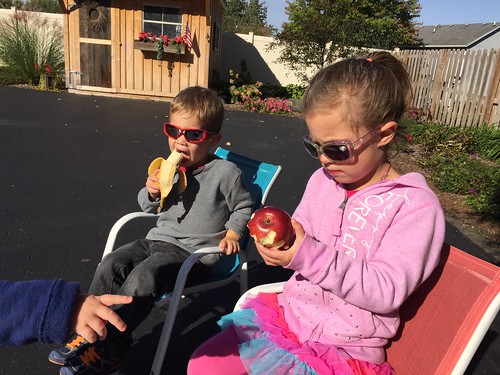




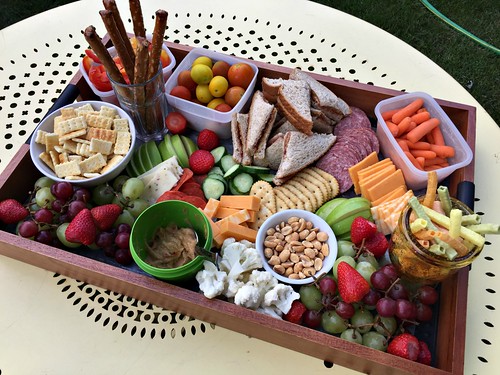





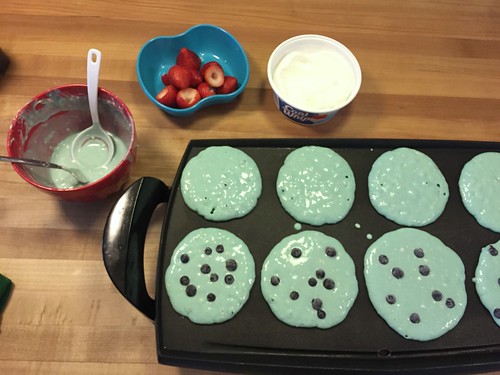



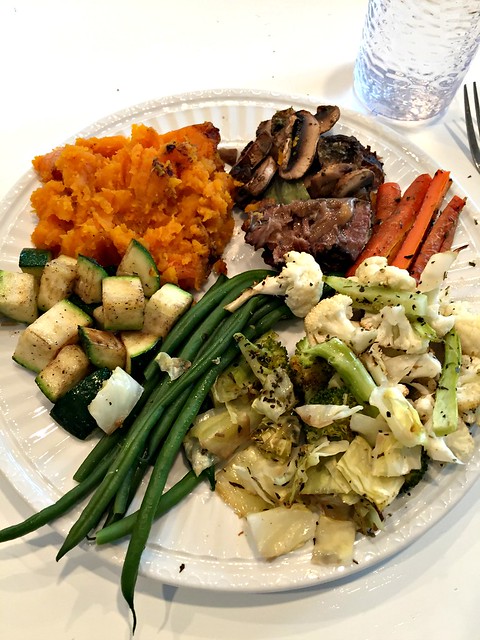

Debbie says
I agree with the other reader that this would probably work for spouses too! LOL! My hubs is a picky eater and won’t eat spaghetti squash, among other things. He does eat roasted veggies and loved the chocolate chip banana bread made with almond flour I make. Andrea, were you going to post a new recipe using almond flour or something? You mentioned it on a FB comment, and I’m dying to know what the recipe is for.
Andrea says
Debbie, I actually just shared my new whole grain banana bread recipe last week — it’s a good one!! https://andreadekker.com/whole-grain-banana-bread/
Kristen @ Joyfully Thriving says
So many great points, as always, Andrea! We do a lot of these already, but I’m going to try offering more sides at our meals. I like that idea. And yes! Repeated exposure is definitely key. Nathan didn’t like broccoli for the longest time, but now, it’s one of the ones he’ll choose over others! I try to let the kids pick our vegetable for dinner (from my choices, of coure) for dinner, so they are more invested.
Leah says
I’m thinking that some of these ideas might work for spouses, as well:)
Andrea says
haha — maybe! 🙂
JJ says
Reading your blog is seriously a highlight of my day!!! And I love all of the comments, too!!! I learn so much. Now, if someone could come trick me with the syrup, that would help, haha!!! My kids and husband love maple syrup, but I like the thickness of the fake stuff. I might have to try this!!!
Now, we eat maple syrup in these granola bars I started making. I had found a recipe and tweaked it for my family. Originally it had brown rice syrup(aMaZinG!?! But expensive!). When ALL of my kids take down food like I take down a brownie, it makes me feel good. Haha! And my kids have a milk allergy, so it sneaks in protein.
4 ingredient granola bars(could be 5 if you add chocolate chips, but chocolate gives my son reflux)
3 cups rolled oats
4 scoops Vegan protein powder(LIVfit Organic Plant Protein (gluten-free/soy free/dairy free)–black scoop provided in bag…could use any powder and probably substitute it with other things
1 cup peanut butter
3/4 cup maple syrup
I literally just mix them all in a bowl and press into a pan lined and hanging over with parchment paper. Refrigerate for 30 min. The original recipe has you melt the peanut butter and brown rice syrup together. I don’t melt the maple syrup and peanut butter. Sometimes my kids eat this fluffed up after I make it and mix it in a bowl with milk(oat milk for one, almond milk for the others). You can add stuff and really make it your own. It’s so so good!!! They are a little crumbly with the maple syrup. Normally that would be an issue for my kids. They don’t like when things fall apart. But they never complain. Haha! If making them to take as a bar to go, I’d use more maple syrup(1 full cup) and slightly more peanut butter or just reduce the amount of oats. I can literally whip these up in under 5 minutes total time. They hold really well with the brown rice syrup. I have also frozen them for 10-15 min for fast served bars.
And we have dessert twice a day, too!!! My grandma lived to be almost 90, and I think she had about 3 servings of dessert a day. Haha! She drank hot tea with every meal. So I’m going that route. Dessert and tea. Haha!!!
Andrea says
well I never have vegan protein powder in the house, but I’m almost tempted to buy it in order to try your recipe!
As for the maple syrup, if you eat it cold from the fridge, it’s MUCH thicker! That’s actually how we eat it because I don’t want to have to heat it up every morning — so we’re used to it cold and it’s nice and thick! try it!
JJ says
OooOoo!!! I just set it in the fridge–thank you for this tip!!! I got the protein powder at Walmart. 3 ingredients: pea protein powder, quinoa powder, natural flavor. I never would have if my poor boy wasn’t going through all his health issues. These bars have saved the day! Haha! And ironically there is no weird taste and no weird side effects. Haha!
Bonnie'sMama says
As an adult, I was delighted to learn that cruciferous vegetables, all of which I have always heartily disliked, contain a naturally occurring compound which certain people are able to taste more than the rest of the population can. This probably explains why I was very picky as a child and still dislike most of the foods I didn’t like then. Having this explanation and experience helps me to be understanding of my children’s dislikes and not make a power struggle out of foods they dislike.
I read somewhere that it often takes trying a food an average of ten times before a child will be okay with eating it. That encourages me to keep working at it over time, while still knowing they may never learn to like certain foods.
One of my friends has a clever strategy with new foods. She fixes only enough for herself and her husband and says that it’s food only for grownups. The children don’t get any for the first several times she serves it. Eventually she relents and graciously allows them to try the grownup food, which by then the children think is really special!
Andrea says
I’ve actually read that it takes closer to 30 tries to acquire a taste for something — but still the same idea that you just need to keep at it!
And yes, I have a friend who wouldn’t let her kids have salads until they are 5… because they were for “grownups”. You better believe the kids were DYING to get their hands on a salad ON their 5th birthday. So clever! Too bad we didn’t think of this earlier!!
Karen says
These are some great tips. I’m going to try to implement some of them. What is helping us right now is letting my 6 year old choose which vegetable she would like with dinner. We’ve been eating lots of roasted broccoli and cauliflower. Almost every night. But, she eats them without complaint – not a lot but still it’s something. She’s more likely to try another veggie with dinner if she knows that if she doesn’t like it – she can have broccoli instead.
Andrea says
choice is always a good thing with kids and food. If they feel like they have a choice, they are more likely to eat (at least in my experience!)
Julie says
The one bite rule has always a rule in our home even for teenagers. You don’t have to eat it all but you have to try one bite. My husband and I follow this rule too. The other food rule we have is that if you refuse dinner thats ok, but you get nothing to eat until breakfast. They can have all the water they want to drink, but no food.
Janet says
This reminded me of a switch I made years ago. My son is 46 but when he was small he only thought he liked the small McDonald burgers. I saved the wrappers. Whenever we had burgers we all got a homemade burger except for the youngest who got a “McDonalds” burger. Haha! Love these hints!
Andrea says
haha — we have friends who do something like this too! 🙂
Jen says
We did much the same with our kids. We didn’t worry too much about sugar, etc. They had their fair share of fruit snacks and candy. I think we were good at balance and all of my kids, as adults, are MUCH more adventurous than their mom. (Fruits and veggies are NOT my fave!) Our rule was generally that they had to have as many bites as their age. For example: if our daughter was four and turned her nose up at peas, she had to eat at least four peas. Of course, as they got older, this wasn’t an issue and we didn’t ever engage in a battle of wills where a child sat at the table for hours until his/her plate was clean. Although, I did, on a few occasions, resurrect the uneaten dinner for lunch the next day. As they got older, our rule was, if they didn’t like what I had made, they could make their own PB&J. That was it! No fixing a completely different meal or making anything elaborate-their only option was PB&J. And, let me tell you, we had one child who had MORE than his/her share of PB&J.
I think it’s important to remember that nothing lasts forever–even their eating is part of a phase which, by definition, WILL have an end. Of course, we want to encourage good eating habits when they’re young but, truly, it will change a million times as they grow, and they’ll probably be just fine when they can make their own food choices. I may not have a very unpopular opinion, but I firmly believe that the current cultural obsession with food–eating the good, avoiding the bad, and everything in between–ALL contribute to how unhealthy and unfit we are. Extremes are almost always a bad idea!
Andrea says
yes, yes, yes, and yes!
Someone I was talking to the other day almost fainted when she realized we eat some sort of “dessert” after lunch and dinner EVERY DAY. She basically implied that my kids were going to be fat and their teeth were going to rot out from the sugar.
Meanwhile, her kids ARE actually fairly overweight for their young age — but she thinks because they eat “gluten free” they are being healthy. They eat all sorts of processed, boxed gluten free foods and she’s condemning my from-scratch oatmeal chocolate chip cookies I offered the kids for a snack (even though they were gluten free!)
Also, we do the “one bite per age” deal for foods as well 🙂
Simon is super bummed that he’s 5 now because that means 5 bites of beans (and he really doesn’t like beans!)
Thanks (yet again) for your super sensible opinions!
Jenny says
Is the gluten-free oatmeal chocolate chips cookies recipe on your blog?
Andrea says
no, but here’s a good gluten free cookie recipe!
Rhonda says
I am not big into reading parenting books, but I will vouch for the valuable information in “How to Talk So Kids Will Listen & Listen So Kids Will Talk” by Faber and Mazlish. I used to be in a “young moms” book club, and we read this one. It was originally published in 1980, but still applies today. I like that the format is such that one wouldn’t have to read it word for word, but there are some helpful cartoon dialogues that help make their points. One major point in the book that a lot of adults miss: acknowledge kids feelings. If your kids say “I don’t want to try that food”. Don’t just push them and say things like “you might like it”. You might try something like “you’re afraid it might taste weird, right?” One time one of my kids told me “I don’t want you to go” as our sitter was here. When I replied “you will miss mommy and daddy, right?” it was like she felt instantly better, and didn’t throw a huge fit when we did try to leave. I also just used some of these techniques on a 7 year old in the hospital I work in. The nurse couldn’t get him to try to swallow pills (which I felt was an age appropriate skill for him to have). His mother stated that he always likes to chew them (despite most pills that aren’t meant for chewing taste REALLY bad!) We didn’t have the liquid option available, and no IV. (I am a pharmacist, btw). I talked to him and asked him about taking the pills. I said “are you scared, because you think it will feel weird going down your throat?” I explained to him that he can put it in his mouth when he felt ready (I let him take it from my hand so he had some power/independence), then just pretend it’s not there and take a sip of water. I also told him how I have 6 and 8 year old kids who swallow pills, and that I thought he would be able to do it too. And you know what…he did it! He felt so proud of himself in that moment. (And I felt proud of myself too!)
Andrea says
wow — this is fantastic. Thanks so much Rhonda!
I’m definitely looking up that book in about 5 minutes! 🙂
Rhonda says
You probably already do a few things mentioned in this book (especially given your psychology background). I’ll be interested to hear later what you think 🙂
Also, I do as you do and offer a pretty fair variety for each meal. Maybe it’s a bit more work, but if I want them to try something they are not that excited about, at least they have some other things they like. (Although, it certainly wasn’t this way growing up in my house…it was pretty much meat-potato, canned veggie OR “hot dish” with a veggie).
Andrea says
Thanks! I put it on hold at the library the other day. Now I’m just waiting 🙂
Nancy says
Chiming in to agree with Rhonda’s recommendation. It is a great book! I especially remember one suggestion, something like magically granting the child’s wish. So simple, but it works when used sparingly. As Rhonda describes, it acknowledges their feelings and puts you on the same team as the child, while also acknowledging reality.
Andrea says
Thanks nancy… I’m glad you mentioned about granting the child’s wish. I actually JUST did this last week for Simon, and I sort of felt like I was giving in, but he was SO happy and thankful!
I had made 2 dinners in a row that I knew he didn’t really love. He ate the first meal OK, but had a very small portion for dinner and was very hungry the next morning for breakfast. So that 2nd night, I felt bad knowing he would most likely only eat a small portion again… I told Dave that if Simon asked for pancakes (which are his favorite) I would say “yes”.
So… when we sat down to eat, Simon said, “please can I just have pancakes?” and everyone was beyond shocked when I pulled the already-made pancake batter out of the fridge. He wolfed down the very small plate of food I served him (the food he didn’t really like) and then ate 4 or 5 huge pancakes and said “thank you mom” at least 5 times.
I agree, if use SPARINGLY this is an excellent tactic for getting kids to try new foods!
Margaret says
No kids of my own, but I’ve been watching my friends raise their children, and have seen a variety of successful methods.
My favorite was my BFF, who told her girls that children and grownups liked different foods, and they would only know if they were old enough to like something if they kept trying it. She only gave them an insect’s helping, but they had to try i
I really liked the way this approach both respected the preferences they had at the time and also let them know those preferences would change, while avoiding both power struggles and catering to pickiness.
It’s just so important to help children develop healthy relationship with food. I LOVE that your children will decline dessert if they are full–and that you let them. I have a lot of issues with food (diagnosed eating disorders, including bulimia, obesity, type 2 diabetes) with origins in being forced to eat. Even with all your issues with Nora, it sounds like you’ve avoided that. Congratulations.
Nancy says
Margaret, I love this approach and wish I’d thought of it when my kids were younger. The other day it finally occurred to me to tell my teen daughter that as she’s fairly open to new experiences generally and enjoys trying ethnic foods, there’s no reason she can’t broaden her horizons and try again to eat vegetables that she thinks she doesn’t like.